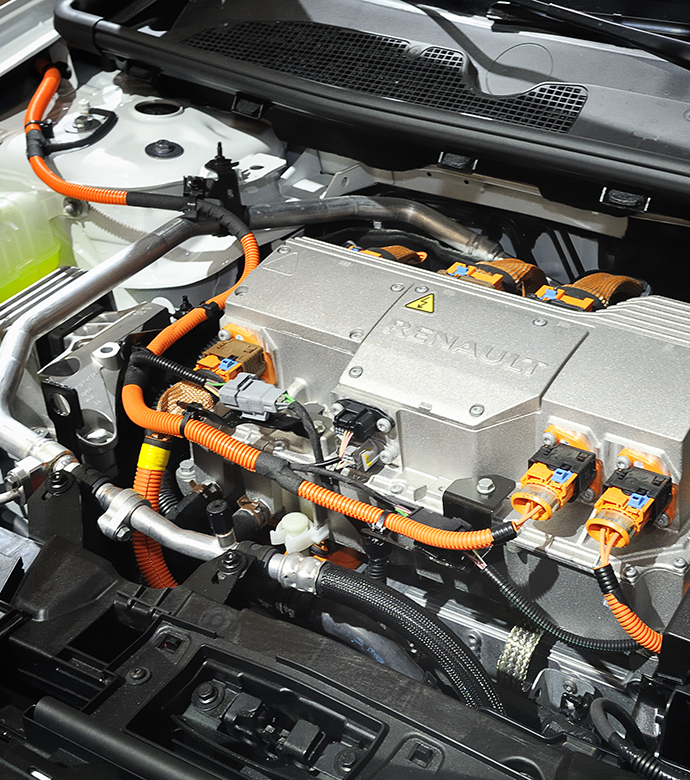Capacitive Pressure Sensor System and Packaging
sensors
Capacitive Pressure Sensor System and Packaging (LEW-TOPS-119)
Proven system provides in-situ data acquisition in extreme conditions
Overview
Innovators at NASA's Glenn Research Center have developed a state-of-the-art packaged capacitive pressure sensor system that provides in-situ dynamic data acquisition in harsh operating environments. Designed to monitor jet turbofan engine health, this pressure sensor can be placed directly on the engine for highly accurate, real-time data analysis. Another unique feature of this simply designed system is that it can be fitted with an antenna to transmit data wirelessly. This smart sensing technology has undergone extensive testing in extreme environments and is expected to play a key role in the development of a suite of next-generation maintenance and monitoring systems. This important sensor system and packaging can provide more accurate data, improve performance, and extend the service lifetime of commercial and military aircraft, automotive engines, power plants, and more.
The Technology
Pressure sensors play an important role in engine maintenance and monitoring systems by diagnosing problems before they happen. To capture the most accurate data, however, these sensors must be placed directly on an engine. In order to withstand extreme temperature and vibration, traditional pressure sensor technologies are bulky and complex, lacking the on-board control of microsystem technologies. Glenn's new capacitive pressure sensor system and packaging is the first of its kind to achieve high-temperature capability while maintaining miniaturization.
This novel system consists of a Clapp-type oscillator that is fabricated on a high temperature alumina substrate. It comprises a silicon carbide (SiC) nitride pressure sensor, a metal-semiconductor field-effect transistor, and one or more chip resistors, wire-wound inductors, and SiC metal-insulator-metal (MIM) capacitors. The pressure sensor is located in the tank circuit of the oscillator so that a variation in pressure causes a change in capacitance, thus altering the resonant frequency of the sensing system. The chip resistors, inductors, and MIM capacitors have been characterized at temperature and operational frequency, and exhibit less than 5% variance in electrical performance. The system, which can be installed with a borescope plug adaptor in an on-wing operating engine, has been extensively tested and proven to operate reliably under extreme conditions. Its compact size, wireless capability, and ability to provide real-time in-situ data acquisition make this technology a game-changer in next-generation maintenance and monitoring systems.


Benefits
- Compact: The first of its kind to achieve high-temperature capability and maintain miniaturization
- Efficient: Maintains a strong signal (97 to 117 MHz) that can be transmitted wirelessly
- Robust: Can withstand a pressure range from 0 to 350 psi and a temperature range from 25°C to 500°C
- Durable: Extends the operational lifetime of key components by enabling closed-loop control
- Proven: Passed acceptance temperature, pressure, and vibration testing at 515°C, 295 psi, and 5.3 G, respectively, in an on-wing operating engine
Applications
- System monitoring
- Aerospace
- Power
- Oil and gas
- Automotive
- Environmental monitoring
- Industrial processes
- Military
- Sensors
Similar Results

Pressure Sensor Mechanism
In operation, this RFID-enabled patented technology reacts to a pressure change causing the passive tag to generate an electromagnetic field. The RFID pressure sensor/passive tag reacts to the electromagnetic field and responds by sending a signal to an interrogator. The interrogator receives the reflected signal, measures the returned signal strength indications ("RSSI") of the reflected signal and sends the RSSI measurements and identification of the responding RFID sensors to the processor to determine the pressure. Potential applications for this technology include remote patient mobility monitoring, robotic control systems, and pressure sensing gloves. Older devices may also be outfitted with these sensors to add pressure-monitoring functionality while avoiding the cost of a total system replacement.

Combined Pressure and Temperature Sensor for Hot Harsh Environments
A team of NASA Glenn researchers has developed a portfolio of SiC-enabled electronics and sensors. SiC's ability to function in harsh environments—high-temperature, high-power, high radiation—enables much better performance in many combustion applications. Building on their successful and miniaturized SiC pressure sensor package, the team added a resistance temperature detector (RTD) to the same chip. Having both sensors on a single SiC substrate facilitates the simultaneous measurement of pressure and temperature. The integrated P/T sensors are fabricated with a prescribed sequence of photo lithography and reactive ion etching fabrication steps to create patterns and structures and deposit RTD elements and other layers. Designed to monitor jet engine health, this P/T sensor can be placed directly on the engine, close to the combustion source, for highly accurate, real-time data analysis. As shown in the figures below, the sensor has been tested and characterized for long-term high-temperature stability and response. The data prove that the sensor’s performance is repeatable, with negligible hysteresis. Compared to conventional silicon piezoresistive sensors, this new sensor is more viable in high-temperature environments.

Damage and Tamper Detection Sensor System
The SansEC sensor system consists of multiple pairs of inductor-capacitor sensors with no electrical connections, which are placed throughout the material being monitored for damage. The sensors are embedded in or placed directly onto the surface of the material. Strains and breaks are detected by changes in resonant frequency read by the accompanying magnetic field data acquisition system. When pulsed by a sequence of magnetic field harmonics from the acquisition system, the sensors become electrically active and emit a wireless response. The magnetic field response attributes of frequency, amplitude, and bandwidth of the inductor correspond to the physical property states measured by the sensor. The received response is correlated to calibration data to determine the physical property measurement. Because each sensor pair has its own frequency response, when damage occurs to that circuit the frequency response changes. This change identifies the damage location within the material.
A unique feature achieved by eliminating electrical connections is that damage to a single point will not prevent the sensor from being powered or interrogated. If a sensor is broken, two concentric inductively coupled sensors are created, thus identifying tamper or damage location.

Polymer Electrolyte-Based Ambient Temperature Oxygen Microsensor
Conventional ambient-temperature oxygen sensors are limited in various ways: optically based sensors can be expensive and challenging to manufacture; electrochemical cells with liquid electrolytes can have limited lifetimes and become leak sources; and both types of sensors are difficult to miniaturize. These problems are addressed with Glenn's novel ambient temperature oxygen microsensor, which is based on a Nafiontm polymer electrolyte, microfabricated using thin-film technologies. In the past, one drawback of Nafiontm film has been that it can lose conductivity when the moisture content in the film is too low, potentially affecting sensor operation. Glenn researchers devised a method to use certain salts to hold water molecules in the Nafiontm film structure at room temperature. The presence of these salts provides extra sites in the film to promote proton (H+) mobility, thus improving film conductivity and overall sensor performance, particularly in arid and high-temperature environments.
The innovative use of metal/metal oxide as the reference electrode enables miniaturization by eliminating the reference gas and sealing the reference electrode. The combination of interdigitized electrodes with the unique metal/metal oxide reference electrode permits sensor operation in either potentiometric or amperometric mode, as appropriate. In potentiometric mode, which measures voltage differences between working and reference electrodes in different gases, the voltage differences can be monitored with a voltmeter; however, the sensor itself does not need a power source. In room-temperature testing, the sensor achieved repeatable responses to 21 percent oxygen in nitrogen (using nitrogen as a baseline gas), and also detected oxygen from 7 to 21 percent, making Glenn's breakthrough technology usable for personal health monitoring as well as fire detection, fuel-leak detection, and environmental monitoring.

Advanced Hydrogen and Hydrocarbon Gas Sensors
In conjunction with academia and industry, NASA's Glenn Research Center has developed a range of microelectromechanical systems (MEMS)-based and Silicon Carbide (SiC)-based microsensor technologies that are well-suited for many applications. The suite of technologies includes hydrogen and hydrocarbon leak detection sensors; emissions sensor arrays; and high-temperature contact pads for wire bond connections.
Currently used to protect astronauts on the International Space Station, the hydrogen and leak detection sensors have many Earth-based applications as well. They can function as a single-sensor unit or as part of a complete smart sensor system that includes multiple sensors, signal conditioning, power, and telemetry. The system can comprise sensors for hydrogen, hydrocarbons, oxygen, temperature, and pressure. The emissions sensor array features a gas-sensing structure that detects various combustion emission species (carbon monoxide, carbon dioxide, oxygen, hydrocarbons, and nitrogen oxides) over a wide range of concentrations. In addition, the emissions sensor array remains highly sensitive and stable while providing gas detection at temperatures ranging from 450 to 600°C. These new sensors provide a combination of responsiveness and durability that offers great value for a wide range of applications and industries.



